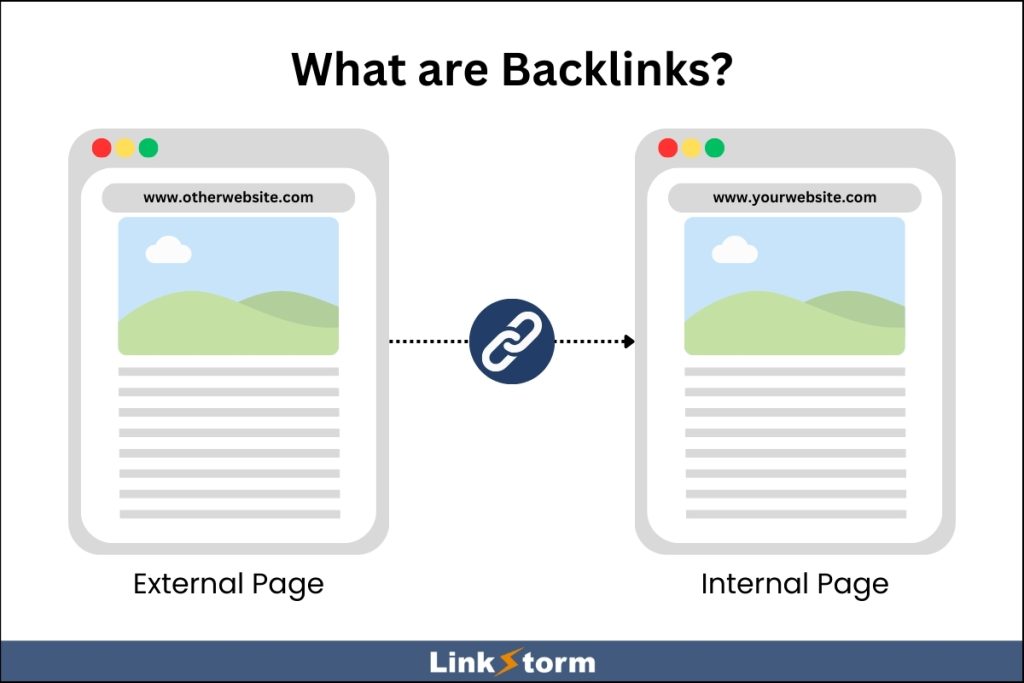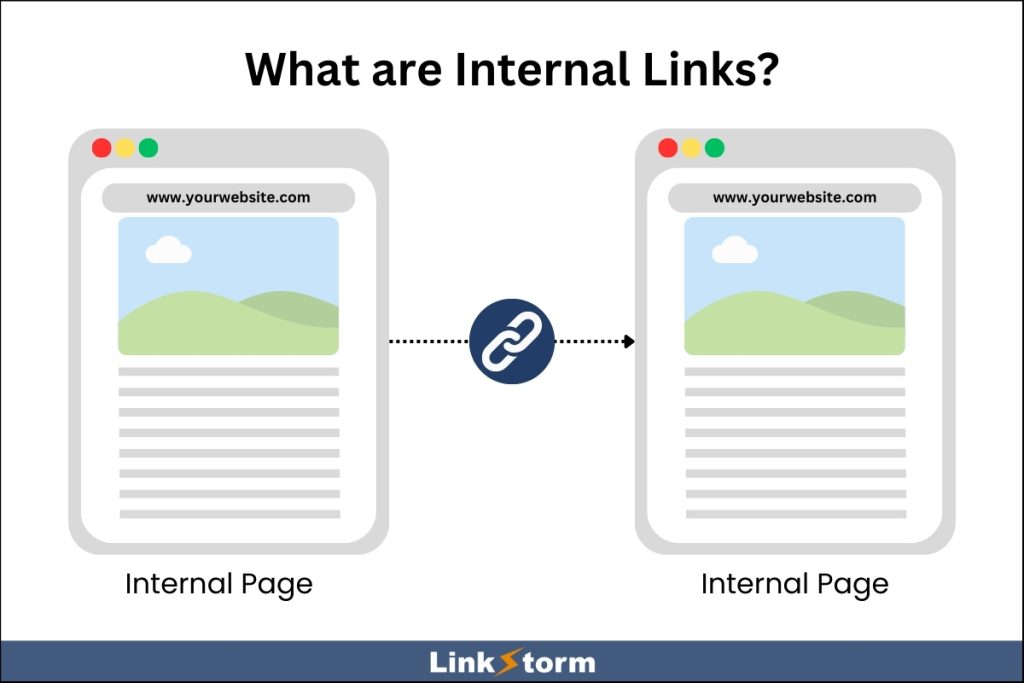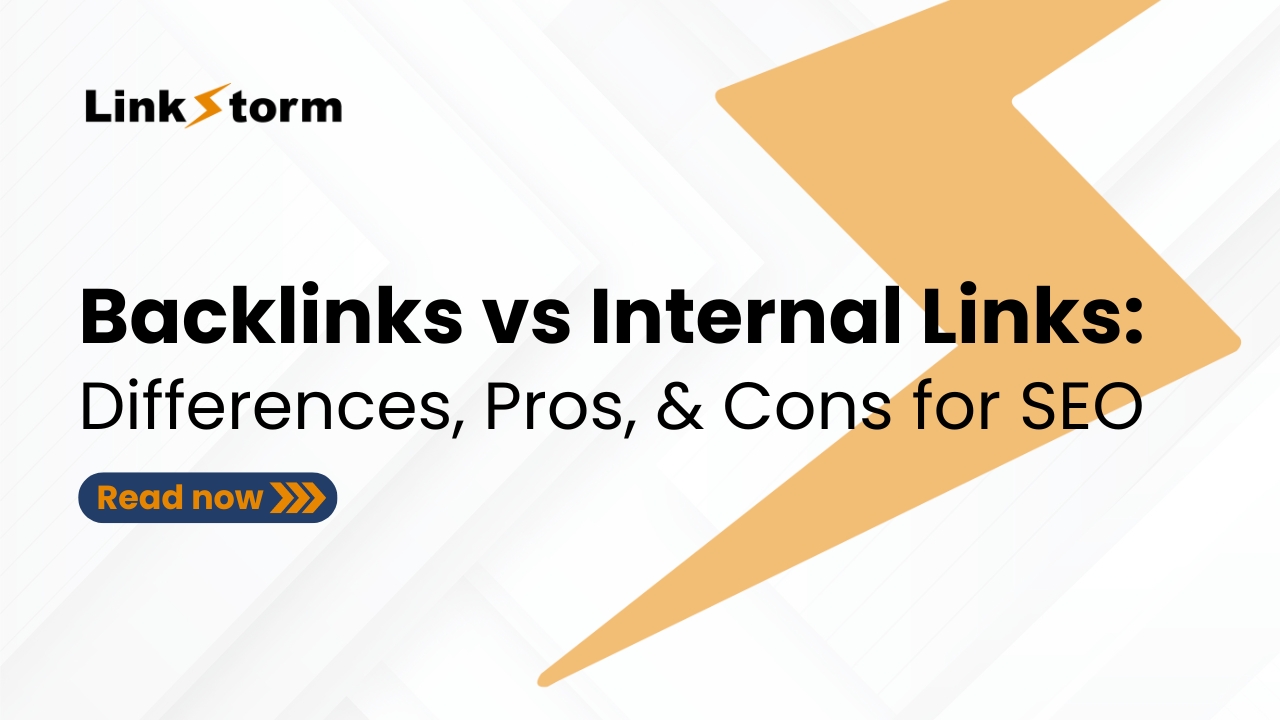For those immersed in digital marketing and SEO, the differences and similarities between backlinks and internal links might seem obvious.
Both are link building techniques, except backlinks come from another website, while internal links connect pages within your website. Beyond the apparent similarities, these two also play distinct yet essential roles in optimizing a website’s search engine rankings.
Knowing the fundamental differences is good, but which of the two is more important for search engine optimization? For example, if you had a limited budget, should you use it to build backlinks or ensure a well-connected website?
Understanding the key differences, advantages, and potential drawbacks of both backlinks and internal links can help you better manage your SEO strategy. This resource will investigate those today.
What are Backlinks?
Backlinks are links from other websites leading to a page on your site. They are also called inbound links because those links drive traffic from external sources into your website. Moreover, the quantity and quality of links on your backlink profile may influence how well your pages rank on Google.

Pros of backlinks for SEO
Here are some of the advantages of backlinks:
Backlinks are a ranking factor
Backlink is the most known and confirmed Google ranking factor. These links help Google assess a website’s relevance and authority. Basically, high-quality backlinks are considered “votes of confidence.” When websites link back to your pages, it means they see you as an authoritative figure and recommend your content to their readers. And more links from trusted websites mean your content may rank higher in search results.
Transfers SEO value
Backlinks share some of the source page’s authority to the target page. This is called link juice or link equity. Earning backlinks from reputable sources transfers more link juice to your pages, which directly boosts your domain authority. On the other hand, your pages receive less equity from low-quality backlinks or those coming from relatively unknown websites.
Drives referral traffic
Acquiring backlinks can help drive traffic from that website to yours when visitors click those links. This is called referral traffic. Referral traffic expands your network, allowing you to reach users outside your reader base. This boosts your brand awareness and visibility. Depending on the quality of your content, this additional traffic to your website may gain you new subscribers.
Cons of backlinks for SEO
Backlinks may be beneficial, but they’re not free of flaws. Here are some disadvantages with backlinks:
Backlinks are not as relevant as they once were
During Google’s early years, they relied solely on backlinks to rank content in search results. However, the algorithm has become more complex and sophisticated since then. Today, backlinks are still relevant, but their significance is much less than in the early years of Google.
Backlinks are still one of the hundreds of ranking signals Google uses to detect content quality and rank it accordingly.
Time-consuming and requires a dedicated budget
Building backlinks to your website takes time. Publishing high-quality content is a non-negotiable if you want other websites to link to your site. If you don’t write, you might have to hire seasoned SEO content writers to create content on your behalf.
Guest posting is a tried-and-tested approach for link building, but some websites require compensation before you can publish on their site. Hiring an outreach specialist to conduct the cold outreach, negotiate your terms, and handle your overall guest posting campaign is also advisable. This, too, requires a monetary investment or the use of email outreach tools.
Spammy backlinks may damage your SEO
Google strongly opposes link spam or unethical link schemes designed to game its ranking system. For example, trading links with other websites (link exchange) for the sake of cross-linking is considered spammy. Buying backlinks without properly qualifying them with the right rel attribute is also a red flag.
Google has systems that detect these changes, and engaging in such changes may expose your site to penalties.
Good backlinks are those links to your website that are naturally created— no sale, no transaction. Unless you get backlinks this way, your website might be in Google’s crosshairs.
What are Internal Links?
Internal links connect different pages within your website. These links are essential for user navigation and maintaining a well-connected website. Internal links differ from external links, which point to a page on another website. Like backlinks, internal links are important for your website and its SEO performance.

Pros of internal links for SEO
Here are the advantages of effective internal linking:
Strengthens your site structure
Structural and contextual internal links comprise the site architecture. These links interconnect the website’s homepage to its major pages and content. Maximizing internal links strengthens the website’s internal linking structure, improving its accessibility for users and web crawlers.
Distributes SEO value
Like backlinks, internal links transfer link juice between linked pages, effectively boosting the ranking of your website. However, many consider link juice from backlinks more valuable, especially from authority websites. This is because link equity from building internal links is limited by the website’s domain authority and the linking page’s page authority.
In other words, low-authority sites will also share low-value link juice from internal links.
Improves site navigation and crawl efficiency
Internal links help site visitors navigate a website. This encourages users to explore relevant content and easily find the information they need, improving the overall functionality of your website.
Effective internal linking also reduces click depth, allowing web crawlers to find new pages and add them to Google’s index. Pages without internal links get orphaned, making them inaccessible to users and non-indexable for Google.
Boosts the relevance of linked pages
Google measures a web page’s relevance using the content of the linking page and the anchor text used in the hyperlink. By using good internal linking practices and descriptive anchor texts, you help Google understand the association between web pages. This ultimately increases the relevance of target pages, helping your website rank better for relevant search queries.
Cons of internal links for SEO
Internal links are great but not perfect. Here are some drawbacks associated with internal links:
Time-consuming and prone to error
Maintaining a well-connected website is tedious, especially for large websites with numerous pages. It requires careful planning and execution to prevent internal links from irrelevant pages. Manually embedding internal links can be repetitive and mundane, which may result in unwanted internal linking errors, like pasting the wrong URL. This could lead to broken links that affect the user experience.
An internal linking tool automates this process, helping you avoid mistakes and ensure all pages are connected. In fact, Steve Hutt, CEO of eCommerceFastlane, reviewed over 43,000 internal links in under two hours using LinkStorm. Read the case study here.
Over-optimization may damage your SEO
Over-optimization, such as spamming anchor text with keywords or embedding too many links per page, may ruin an internal linking strategy. These bad links may raise Google’s suspicion, exposing your websites to potential penalties. Maintaining a natural-looking internal link profile is as important as a spam-free backlink profile.
Key Differences Between Backlinks and Internal Links
While internal linking and backlink acquisition are both link-building techniques and play crucial roles in SEO, they differ significantly in many aspects. Understanding these distinctions can help you decide whether to use backlinks or internal links in certain SEO campaigns.
Below, we explore the specific aspects where backlinks diverge from internal links:
1. Origin and destination
Backlinks always originate from external pages and point back to links on your website. On the other hand, internal links connect pages within your own website. This distinction is crucial because whichever type of link you use will affect your marketing campaigns differently.
For instance, since backlinks originate externally, they are more useful in bringing visitors to your website when they click the link. Meanwhile, internal links don’t drive fresh traffic, but they can potentially increase page views per session and lengthen dwell time, which are also essential SEO metrics.
2. Purpose
The difference between internal links and backlinks extends to their purpose.
Incoming backlinks suggest that websites recognize or attribute your content. It’s essentially a public announcement [primarily to Google] that your content is note-worthy and deserves recognition, and Google picks up on these signals to reward your content accordingly.
Internal links are primarily used to improve user navigation and help users discover relevant content. Search engines also use internal links to understand your website’s architecture and see how pages are interrelated.
Here’s how John Mueller described the importance of internal links on Google:
3. SEO value and impact
Backlinks offer a more straightforward effect on a website’s SEO. Whenever a page earns backlinks, a portion of the linking page’s authority or link juice is transferred to the target link. Many case studies show a direct correlation between backlinks and a page’s SERP rank.
In essence, more backlinks pointing to your page increases its chances of ranking high on Google. While internal links also distribute link juice, the site’s overall authority limits the amount, making them less pronounced than backlinks.
The impact of internal links is more indirect, playing a supporting role in a website’s SEO performance. Internal links benefit a website’s SEO more by boosting web crawlers’ crawling and indexing efficiency. Descriptive anchor texts also help Google understand the relevance and relationships across web pages.
4. Level of control
Internal links are entirely within a site owner’s control. They can freely create, modify, or remove them to optimize a website’s structure.
Conversely, site owners have limited control over backlinks since that power rests on external sites. While we can implement strategies to attract high-quality backlinks, we cannot create or modify them directly.
Even in the case of guest posts, senders cannot always be liberal about inserting links into the content because websites often have strict guidelines on backlinks.
Internal Links vs Backlinks: Which is More Important for SEO?
Internal linking and backlinks might seem similar at first glance, but they are worlds apart when you look closely. Considering their distinctions, pros, and cons, which is more important for SEO?
Not one is more important than the other. Both internal links and backlinks are a cornerstone of a comprehensive SEO strategy.
Sure, more backlinks can increase your visibility on SERPs, but without internal links, Google might not discover and index your content in the first place. On the other hand, focusing on internal links makes user navigation easy, but without building high-quality backlinks, your domain will lose to more competitive websites in your niche.
Internal links and backlinks work side-by-side, and prioritizing one over the other severely limits how well your website ranks on search results.
Differentiating backlinks from internal links is not a matter of which is better, but how to balance both effectively on your website.
Automate Your Internal Linking with LinkStorm
Need help establishing a well-connected website minus all the hassle and tedium of manually embedding links? LinkStorm can help.
LinkStorm automates the internal linking process by finding linking opportunities, identifying sitewide issues, and optimizing anchor texts, so you don’t have to. Visit LinkStorm’s pricing guide to see which plan suits your needs best.
If you’re interested to learn more about internal linking, check out our full suite of resources.
Happy linking!

Leave a Reply